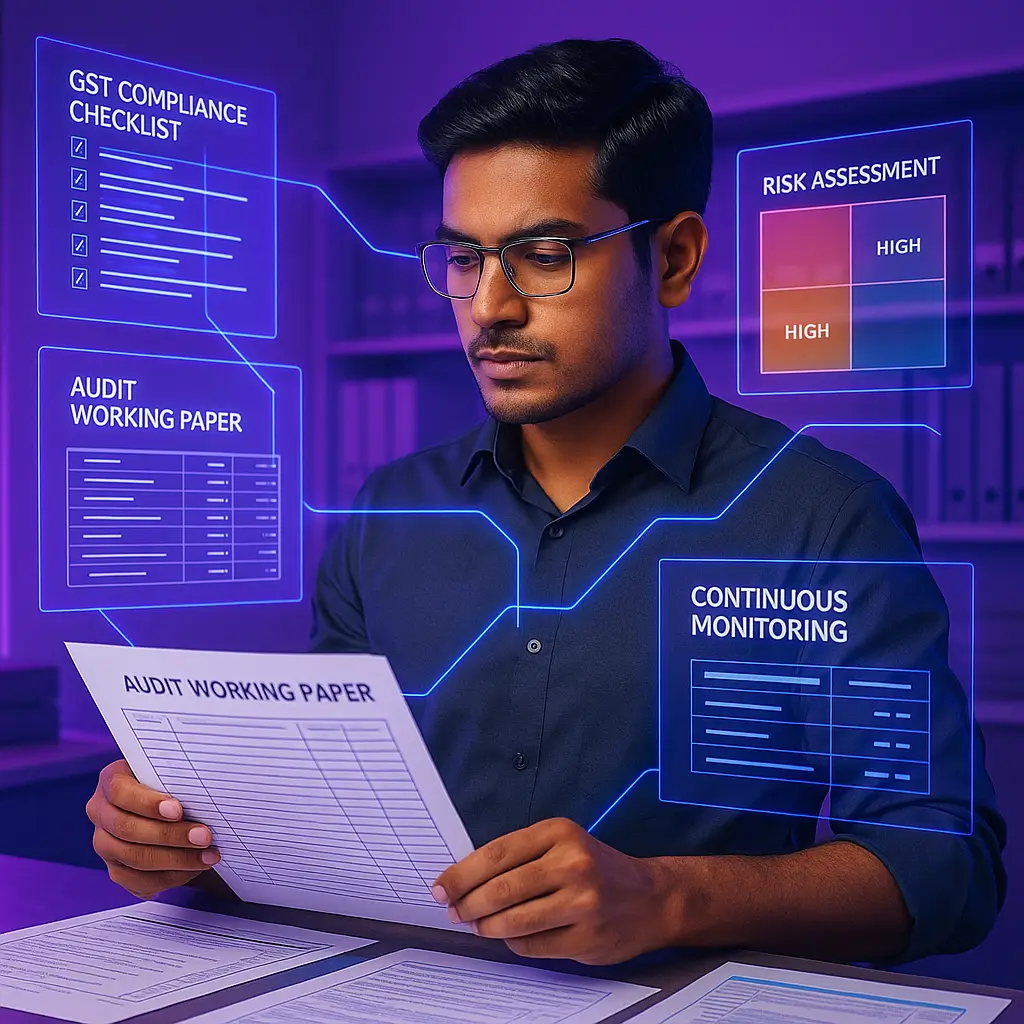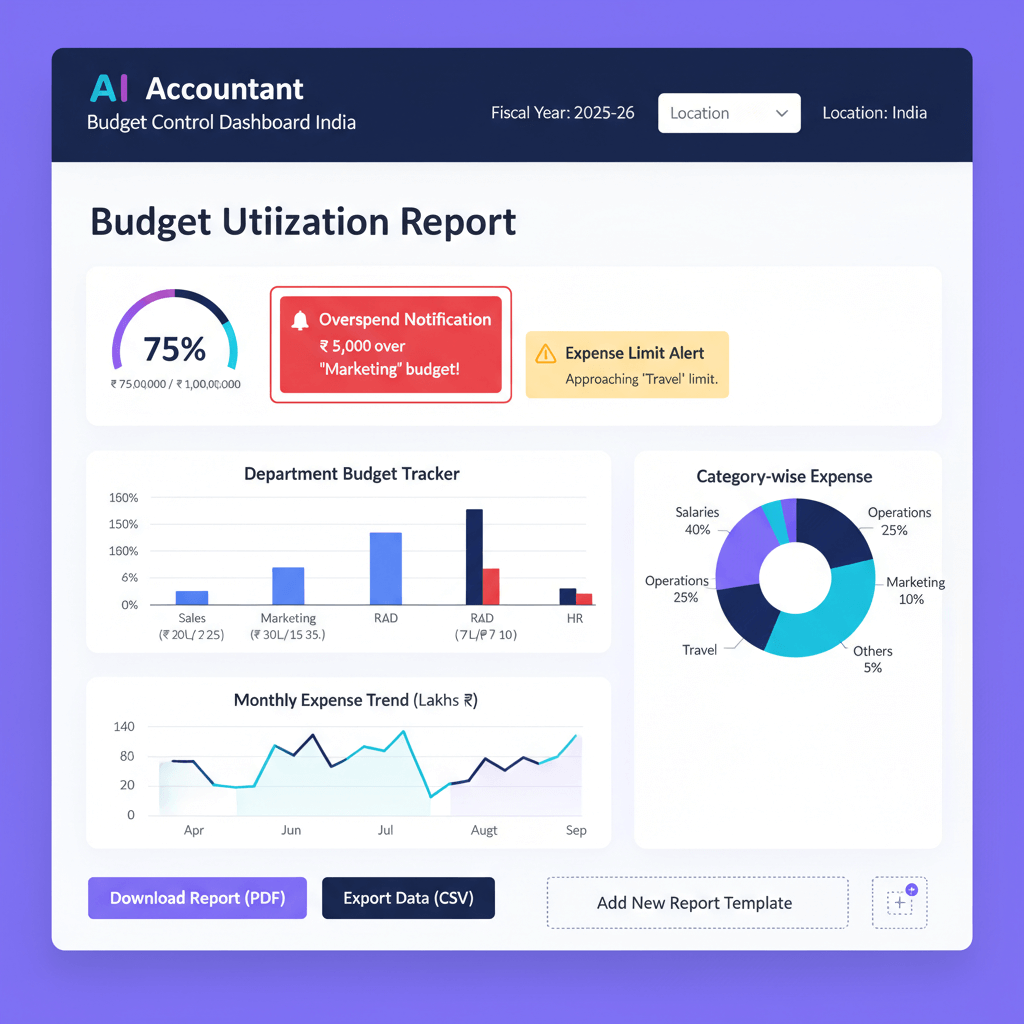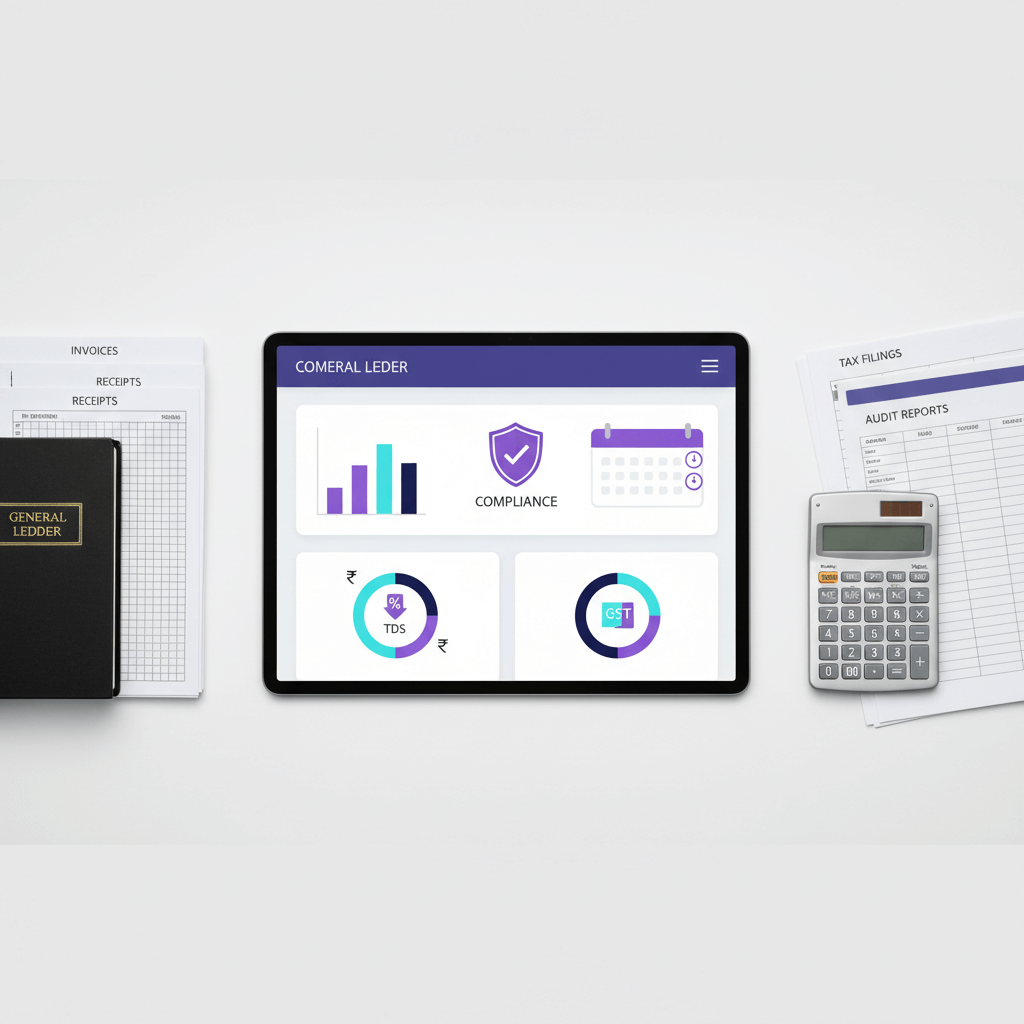Key takeaways
- Manual audit processes in India struggle under complex GST, TDS, and multi-entity demands.
- AI audit tools in India accelerate data processing, enhance anomaly detection, and standardize documentation.
- Features like continuous auditing and risk-based analytics deliver real-time insights and focused reviews.
- Indian-focused solutions integrate seamlessly with Tally, Zoho Books, and local compliance workflows.
- Adopting AI-driven assistants empowers CAs to shift from data gathering to strategic advisory.
Table of contents
- Key takeaways
- Why Internal Audit Procedures in India Need a Tech Upgrade
- Gaps in Traditional Audit Methods Are Creating Business Risks
- Multi Entity Environments Demand Scalable Solutions
- What Are AI Audit Tools?
- From Static Checklists to Intelligent Assistants
- Built for Indian Business Reality
- The Quiet Assistant Philosophy
- Key Capabilities of AI Audit Tools for Indian Use Cases
- Automate Internal Audit Procedures
- Continuous Auditing Software Features
- Risk Based Audit Analytics
- FAQ
Why Internal Audit Procedures in India Need a Tech Upgrade
Picture this: it’s 11 PM, and you’re still cross-checking bank statements against ledger entries, trying to spot that one mismatched transaction before tomorrow’s client meeting. Your eyes are tired, your coffee is cold, and you know there has to be a better way.
“Manual processes that worked five years ago now buckle under the weight of digital transactions, multiple bank accounts, and complex regulatory requirements.”
In today’s compliance-heavy landscape, Indian firms face mounting pressure from monthly GST returns, quarterly TDS filings, and ever-changing formats. Spreadsheet-based reconciliations create bottlenecks, increase error rates, and push audit teams into reactive firefighting mode.
The solution isn’t working longer hours. It’s working smarter with AI audit tools in India that understand local challenges and streamline every step of your workflow.
Gaps in Traditional Audit Methods Are Creating Business Risks
Walk into any CA firm during audit season, and you’ll see piles of printouts, multiple Excel files open, and auditors manually sampling transactions hoping to catch anomalies in a sea of data.
- Limited Coverage: Manual sampling covers just 5–10% of transactions, leaving the rest hidden from view.
- Human Error Factor: Fatigue leads to classification mistakes, missed patterns, and increased compliance risks.
- Time Lag Issues: Discovering discrepancies months later means memories fade, documents vanish, and corrections get costly.
Modern audit teams need real-time insights, comprehensive coverage, and consistent accuracy across all transactions.
Multi Entity Environments Demand Scalable Solutions
Today’s successful businesses rarely operate through a single entity. A typical growth-stage company might have:
- A holding company for investments
- An operating company for day-to-day business
- A separate entity for real estate holdings
- Multiple state registrations for GST purposes
- Different banking relationships across entities
Managing audit procedures across this complexity manually is like solving a Rubik’s cube while blindfolded. Automation-enabled workflows create consistency, reduce manual effort, and provide standardized evidence collection across all entities and clients.
What Are AI Audit Tools?
From Static Checklists to Intelligent Assistants
Traditional audit software was essentially a digital filing cabinet—it helped organize checklists and store documents, but the heavy lifting still fell on human auditors. Today, AI audit tools in India apply machine learning to perform audit procedures:
- Read and interpret bank statements in multiple formats
- Identify unusual transaction patterns automatically
- Cross-reference data across different systems
- Generate insights and flag potential issues
- Learn from historical data to improve accuracy over time
Built for Indian Business Reality
Indian-focused solutions come pre-configured with:
- GST rate tables and classification logic
- TDS calculation and validation rules
- Indian banking format recognition
- Tally and Zoho Books integration
- Support for multiple regional languages
- Understanding of local vendor and customer naming conventions
The Quiet Assistant Philosophy
These tools work quietly in the background, processing data and surfacing insights only when you need them. The result:
- Less Learning Curve: Intuitive interfaces feel familiar.
- Minimal Disruption: Enhance existing workflows rather than replace them.
- Focus on Value: Invest saved time in high-value analysis.
- Gradual Adoption: Start small and scale usage as confidence grows.
Key Capabilities of AI Audit Tools for Indian Use Cases
Automate Internal Audit Procedures
The most immediate benefit is the ability to automate internal audit procedures that traditionally consumed hours of manual effort:
- Transaction Scanning and Anomaly Detection: Process thousands of transactions in minutes and flag unusual patterns.
- Standardized Working Papers: Generate consistent documentation with embedded evidence links.
- Evidence Trail Automation: Maintain complete audit trails showing data sources, rules applied, and results.
- Ledger Reconciliation: Match sub-ledger to general ledger entries and suggest corrections.
Continuous Auditing Software Features
Move from point-in-time reviews to ongoing validation:
- Real Time Monitoring: Flag potential issues within hours of transaction posting.
- Exception Based Reporting: Focus on outliers rather than every single entry.
- Automated Alerts: Notify team members immediately when thresholds are breached.
- Dashboard Visualization: See key metrics and trends at a glance.
- Configurable Rules: Tailor rules and thresholds to each client’s risk profile.
Risk Based Audit Analytics
Not all transactions carry equal risk. Risk-based analytics help auditors focus on high-impact areas:
- Risk Scoring Algorithms: Assign risk levels based on amount, timing, vendor history, and more.
- Historical Pattern Analysis: Establish baselines and flag deviations automatically.
- Predictive Analytics: Anticipate future risks like potential cash-flow issues.
- Heat Map Visualization: Highlight high-risk accounts, vendors, or transaction types.
- Integration Benefits: Combine data from Tally, Zoho Books, and banking systems for comprehensive risk assessment.
FAQ
How can AI audit tools help automate bank reconciliation for Tally data?
AI audit tools connect directly to your Tally export, read ledger entries and bank statements, and apply matching algorithms to reconcile transactions automatically. They flag mismatches, duplicate entries, and suggest corrections, reducing manual effort by up to 80%.
What features should an AI internal audit solution for Indian CAs have?
Look for built-in GST rate tables, TDS validation rules, Indian banking format recognition, Tally and Zoho Books integration, and support for regional languages. Solutions like AI Accountant come pre-configured for local compliance.
How does continuous auditing differ from traditional quarterly audits?
Continuous auditing monitors transactions in real time or near real time, flagging exceptions as they occur. Traditional audits happen at fixed intervals, leading to delayed issue detection and corrective action.
Can AI-driven risk analytics flag GST compliance issues in real time?
Yes. AI-driven tools assign risk scores to transactions based on GST rates, input tax credits, and reverse charge rules. They instantly alert you to anomalies like incorrect rate application or missing e-way bills.
Is it difficult to integrate AI audit tools with existing ERP like Zoho Books?
Most Indian-focused AI solutions provide native connectors for popular ERPs, including Zoho Books and Tally. The onboarding wizard guides you through API setup and data mapping, typically completing integration within a few hours.
How does AI Accountant ensure data security and confidentiality?
AI Accountant uses end-to-end encryption, role-based access controls, and audit logs. Data at rest and in transit is secured, and only authorized users can view or export sensitive information.
What is the onboarding process for deploying AI audit tools in a CA firm?
Onboarding usually involves a kickoff call, system integration, configuration of client profiles, and a pilot audit. Training sessions for auditors and ongoing support ensure smooth adoption and gradual feature expansion.
How do AI models adapt to changing GST or TDS regulations?
AI tools receive regular updates to GST and TDS rule engines. Machine learning models retrain on new data, ensuring classification logic and validation rules stay current without manual reconfiguration.
Can AI audit tools generate audit working papers automatically?
Yes. Modern AI audit platforms create standardized working papers with embedded evidence, cross-references, and audit trails. You can customize templates to match your firm’s documentation standards.
How do I start a pilot with AI Accountant in my practice?
Contact the AI Accountant team to schedule a demo and pilot. Provide sample data from one or two clients, define scope, and run a parallel audit. Compare results, refine rules, and then scale across all clients.

-01%201.svg)



